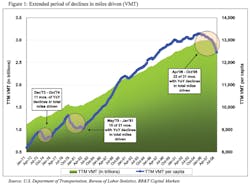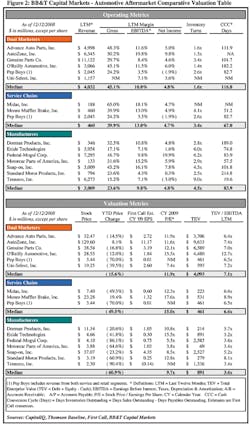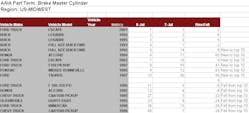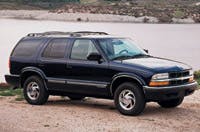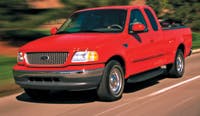Chevy built the X-77 Z/28 Camaro for road racing.
The origins of the Z/28 Camaro date back to late 1966 when plans were made to launch the all-new Chevrolet "pony" car. Vince Piggins (Chevrolet's production promotion manager at the time) had noticed a new and growing road-racing class called "Trans-Am" (Trans American Sedan Series) and he pushed product planners for a new option package that would make the Chevy pony car a competitor in the exciting Trans-Am series. The pony cars were eligible to compete in the "sedan" series because they had a back seat.GROWTH OF THE TRANS-AM CLASS
Trans-Am was a new class the Sports Car Club of America (SCCA) had come up with and it specified that the cars not have engines with displacements larger than 305 cubic inches (five liters), weigh no less than 2,800 lbs., and limit wheelbase to 116 inches and shorter. Solid rear axles were mandatory and any entry had to be "homologated" by the Fédération Internationale de l'Automobile (FIA) governing body, which meant GM had to build a certain number of vehicles (500 at that time) and they had to be available to the public.
With the blessings of Elliott (Pete) Estes, Chevy's general manager, a new 302-cubic-inch V-8 engine was created to best fit the Trans-Am class. The engine size was achieved by matching a 327-cubic-inch block with a 283-cubic-inch crankshaft, providing an ideal 4x3-inch bore-to-stroke ratio. The actual engine displacement is 302.4 cubic inches, and with Corvette L79 cylinder heads (2.02 intake, 1.60 exhaust), a solid lifter cam, 11.0:1 compression ratio, 800-cfm carburetion with aluminum "tuned-length" high-rise intake, the powerplant is a potent and high-revving screamer! However, the factory rated the engine's horsepower at just 290.When you add in the F&R heavy-duty springs and shocks, shot-peened front ball studs, a rear radius rod (located on passenger's side), mandatory Muncie close-ratio 4-speed manual gear box, and front disc brakes (power), which the package also requires, it's easy to see the Z/28 is built for serious performance.
Available as an option, a fresh-air kit—where air is fed via a plenum induction setup fitted to the air cleaner—draws fresh air from the vents in the cowl area in front of the windshield. Chevy even offered tubular headers ($437.10) for the nimble handler, but they came in the trunk, rather than already fitted to the engine. However, with headers from the corner speed shop selling for only $150 a set, not many buyers opted for the factory tubes.DEVELOPING THE Z28
Z27 was the regular production order (RPO) for the Camaro SS350, and the next number in the sequence was Z28. During the car's planning stages, someone in the Chevrolet organization noted the car was going to be known internally as "RPO Z28," and said, "Let's just call it Z28!" So the name stuck. The marketing folks inserted a slash between the Z and the number 28 and the rest is automotive history.
Chevrolet described the first Z/28 option in its literature as a Special Performance Package; which included a 302-cid V-8 engine, closed positive ventilation, dual exhaust with deep tone mufflers, special front and rear suspension, heavy-duty radiator and temperature-controlled fan, quick ratio steering, 15x6-inch wheels, 7.35x15-inch nylon red-stripe tires, 3.73:1 ratio axle, and special paint stripes on the hood and rear deck. The V-8 sport coupe required a 4-speed close-ratio transmission, power brakes, front disc brakes or HD front disc brakes with metallic rear brakes, and recommended Positraction.About 602 buyers stepped up that first year for the car, which was basically built for racing and not marketed for street use. Chevy dealers that promoted performance (Yenko, Nickey, Ron Tonkin, etc.) received many of the cars, but customers could order the RPO Z28 option at any Chevy dealer. The cost for this package was $437.10.
After testing the new-for-'67 Z/28 in their March 1967 issue, Car & Driver said, "The 302 engine is without a doubt the most responsive American V-8 we've ever tested, although there is a trace of unevenness at low speeds because of the carburetor's unusually large venturi area. Once it begins to pull, however, it smooths out and lunges forward like a 426 HEMI.""CLOSEST THING TO A CORVETTE YET"
How fast was a race-prepped 1967 Z/28? Famed car builder and mechanic Smokey Yunick found out one day in October 1967 at the Bonneville Salt Flats. With Mickey Thompson behind the wheel, Yunick's immaculately prepared Camaro ran 174.344 mph in the flying mile, setting a new Class C American Stock record. Not bad for just 302 cubic inches and a single four-venturi carburetor.
In a March '68 HOT ROD magazine article, Yunick explained how he was able to get the 302 to perform so well, showing readers the various technical upgrades he performed to the Bonneville-conquering Z/28 engine (revealing his rod and piston modifications, engine clearances, cylinder-head porting details, etc.) and stating that if his "best damn garage in town" advise is followed, "you'll have built yourself a 465-plus horsepower package that'll nearly go to the moon." And that was running it hard, 7,500-8,000 RPM "of steady runnin' and with no broken pieces," Smokey stated.Chevy advertising for the '68 Z/28 was pretty direct in its wording. "Closest thing to a Corvette yet" is how it read. The full-page ads listed the engine/chassis features (including the N40, 17.9:1 fast steering ratio that was available) and said the big, bold stereo rally stripes had "no mechanical function, but having great psychological value." The ad copy specifically stated, "Special order Z/28 and you get a Camaro that comes on like a Corvette...for a lot less."
Things began to get even more radical under the hood for the Z/28 Camaro. In November 1967 (the 1968 model year), a special "Cross-Ram" 2x4 intake was made available (SCCA had changed the rules to now allow multiple carburetion). The package included an aluminum two-piece manifold (cast by Winters Foundry), plus a pair of dual-feed, double-pumper Holley four-venturi carburetors, complete with center-pivot floats. (Early cross-ram packages came with # 3810, 585-cfm carburetors; later they changed to # 4295, 600-cfm units.)Of course, the use of twin four-venturi carburetors could be considered "overkill" for street use or when fitted on unmodified engines. When Car Life magazine tested a Cross Ram '69 Z/28 in their August 1969 issue, they stated, "The extra power isn't usable." However, they seemed to like the car as equipped, as they summed up the story with this closing remark: "The Z/28's main attraction is that it's a race car that doesn't have to be raced. The excellent handling, the demanding but responsive engine, even the distinctive sound, make it a delight to drive, even without the lure of the stoplight Grand Prix."
While street Z-28s may not have needed the massive intake system, racers needed it to keep up with the competition on the SCCA Trans-Am racing circuit. A race-prepped 302 could really take advantage of the new multiple-carburetor intake system, and it provided an impressive torque curve from 4,000 to 6,500 RPM.GET THE SCOOP
By the time the 1969 Z/28 was released, the unique Camaros were selling better with 7,199 of the 1968 units sold. "We only planned on selling about 400 Z/28s in 1968, but instead, we had 7,000 orders," said Estes, the Chevy boss man. "Boy, there are kids out there, and they have money. And when they hear how Mark Donohue cleans up in Trans-Am with a Z/28, they've just got to have one for themselves," he added. In the end, Chevrolet sold 19,014 of the 1969 model year Z/28s.
New for 1969 were four-bolt mains and available four-wheel disc brakes. For added flash plus function, a special "cowl induction" hood was new, which was dubbed "Super Scoop" by Chevrolet's advertising department. Originally designed back in mid 1967 by famed designer Larry Shinoda, the scoop incorporated a reverse drafting method of drawing in air as opposed to a traditional front-facing scoop. It took until 1969 for the SCCA to open up the rules to allow hood scoops in the Trans-Am series, and the rules stipulated they must be low in height to not cause front vision problems.Donohue was the hotshot driver of the Penske Camaro that Estes was talking about (funny how Chevy claimed they were not involved in racing during this era), and in 1968, Chevrolet won the points championship and again in '69, with Penske Camaros dominating and winning 18 of 25 events entered.
AN UNFAIR ADVANTAGE?
The Penske Camaros were radical in design and featured "acid-dipped" bodies for weight loss, aluminum bumpers, and numerous tricks that gave them what could be considered an "unfair advantage." Jim Travers and Frank Coons (Traco Engineering) built the engines and the sponsor was Sunoco Oil.
The cars ran on-board computers and GM supplied an unmarked van near the race tracks that provided support to the Camaros via radiotelephone links, recording every suspension movement and engine reading as the car traveled around the race course. The "telemetry van" was a secret deal and the data that was supplied was rather valuable for set-up and tuning purposes.
The final SCCA points standing for 1969 saw 78 points for Camaro, 64 for Mustang, 32 for Firebird, and 13 for Javelin. Camaro was the king of pony cars on the track and on the street. Ford's Parnelli Jones was not real happy when the Camaros ran off with the championship, and he later admitted he never really got along with Donohue. They raced "no holds barred" that year and there was no love lost between the teams.
The Ford team was openly factory-backed, but the Chevy camp was not promoted as having full-on factory support. Years later, PJ was quoted as saying: "We all knew that was total bullshit," as he pointed out half of the Penske crew came from the Chevrolet factory. Imagine the anger if that telemetry van had been discovered.
The pictured X-77 Camaro (X-77 is factory lingo meaning base car with special performance equipment [RPO Z28]) is owned by Bill Wiemann of Fargo, North Dakota, who has a world-renowned muscle-car collection. This car was purchased largely because it was well presented, it drove well, and basically was in "brand-new" condition. It's a true time-warp machine.
This particular Hugger Orange (color-code 72) car was built at the Norwood, Ohio, GM assembly plant, and years later, restored to museum standards by Mark Young and crew at The Chev Connection in Portland, Oregon www.thechevconnection.com.
Unique features include D80 front and rear spoilers, 15x7-inch Rallye wheels, and Houndstooth Deluxe interior. The car was ordered without a center console, but with an 8,000-RPM tachometer, so the factory located the fuel-level gauge in the center of the instrument panel. The "radio-delete" feature includes a block-off plate from the factory and no outside antenna. In addition, it's a Positraction car that comes with a sport steering wheel (with tilt) and power steering. While the original parts are rather hard to locate, this machine's engine has all the stock 1969 smog equipment.
When this bright-colored Z/28 is taken out for a drive and the dual Holley carburetors are at wide-open throttle, it brings back fond memories of the glory days of high-performance pony cars and also when Donohue and team were out there kicking ass on the competition. With all the special attention the Chevy engineers gave the first-generation Z/28s, they really did have an "unfair advantage!"
SOURCES
The Chev Connection
Holley
Sports Car Club of America

